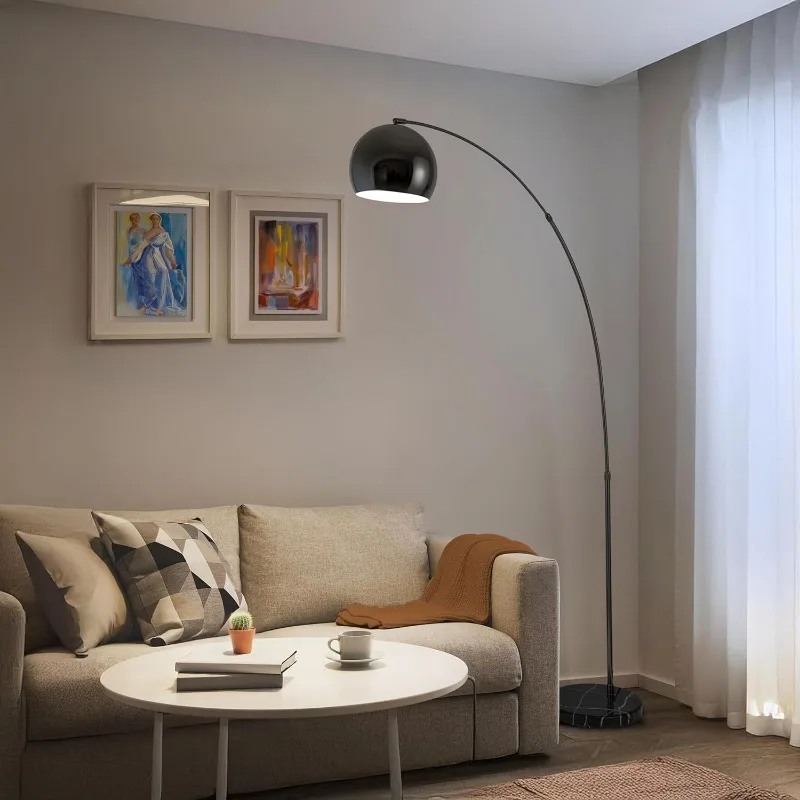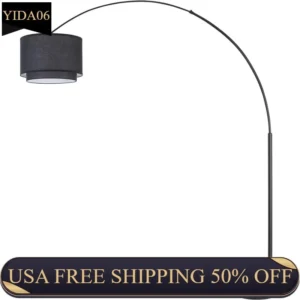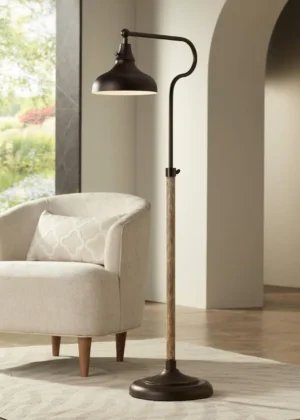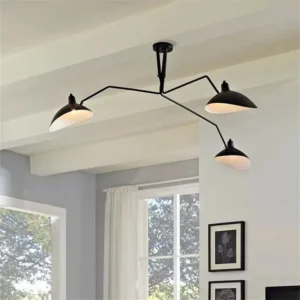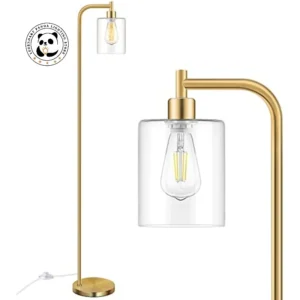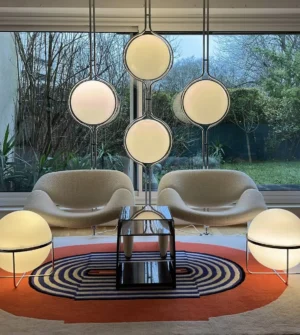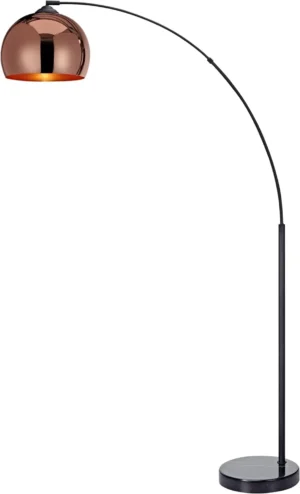Introduction: Understanding Arc Floor Lamp Stability Challenges
Arc floor lamps represent a perfect blend of form and function in modern interior design. With their distinctive curved stems that extend outward and hover over furniture, they provide directed lighting while making a bold style statement. However, this cantilevered design creates inherent stability challenges that must be addressed through thoughtful engineering and construction.
Stability in arc floor lamps isn’t merely an aesthetic concern—it’s fundamentally about safety and functionality. A lamp that tips easily presents a hazard in any home, particularly in households with children or pets. Even minor instability that causes wobbling can be frustrating and affect the lamp’s performance and longevity.
The challenge lies in balancing visual elegance with practical stability. The dramatic curve that makes these lamps so visually appealing is precisely what creates the physical forces that must be counterbalanced. Understanding the ultimate guide to arc floor lamp base design helps consumers make informed decisions when selecting these statement pieces.
Home furnishing tip-over incidents account for thousands of emergency room visits annually, with lighting fixtures being a significant contributor to these statistics. By understanding the essential elements that contribute to arc lamp stability—weight distribution, base footprint, and quality construction—you can enjoy both the beauty and safety of these distinctive lighting fixtures.
The proper stabilization of floor lamp bases isn’t just about preventing catastrophic tipping; it’s about creating a lighting fixture that remains perfectly positioned and functions as intended for years to come.
The Physics Behind Arc Lamp Stability
Arc floor lamps operate on basic physics principles that anyone can understand. The curved design creates what engineers call a cantilever—a structure supported at only one end. This design creates forces that must be counterbalanced to prevent tipping.
Think of a seesaw on a playground. When a heavier person sits on one end, the lighter person on the other end rises into the air. Arc lamps work on a similar principle, but in reverse—the “weight” is the extended lamp head, and the counterbalance is the base.
The physics concept at work is torque—essentially a rotational force. The longer the arc extends from the base (the moment arm), the greater the torque trying to tip the lamp over. This is why lamps with longer arcs require proportionally heavier bases to maintain stability.
The fulcrum point—where the lamp’s pole meets the base—becomes critical in this equation. This connection must be robust enough to transfer the counterbalancing force from the base through the entire structure.
The same principles that govern crane design in construction apply to your living room arc lamp. Just as a crane uses a counterweight to balance the load it’s lifting, a well-designed arc lamp uses its base weight to offset the extended arm and lampshade.
Understanding these principles helps explain why quality arc lamps often have surprisingly heavy bases—they’re designed according to physical laws that cannot be circumvented, only accommodated through smart design. The weighted bases for arc lamps provide the necessary counterforce to maintain stability and prevent unwanted movement.
Essential Base Weight Requirements for Stability
When evaluating arc floor lamps, base weight stands as the single most critical factor for stability. Unlike traditional floor lamps with vertical designs, arc lamps require substantial counterweight to offset the horizontal extension of their arms.
The relationship between arc length and required base weight follows a direct correlation—the longer and more dramatic the arc, the heavier the base needs to be. This isn’t just about preventing catastrophic tipping; sufficient weight also prevents subtle wobbling that can occur when adjusting the lamp or from minor bumps.
Optimal weight distribution within the base further enhances stability. While overall mass matters, how that mass is distributed makes a significant difference. Quality designs concentrate weight lower in the base, creating a lower center of gravity that increases stability. Some designs distribute weight toward the side opposite the arc’s direction, further counterbalancing the extended arm.
Common materials used in quality arc lamp bases include:
- Marble and stone: These natural materials combine substantial density with luxurious aesthetics. The veining and color variations in marble also make each lamp unique while providing excellent weight-to-size ratio.
- Cast iron: This traditional material offers exceptional density and durability. Its concentrated weight makes it ideal for smaller footprint bases that still require substantial mass.
- Steel: Modern steel bases offer versatility in design while maintaining excellent strength. Often used in contemporary designs, steel can be formed into various shapes while providing necessary weight.
- Concrete: As a contemporary option, concrete offers excellent weight at a more accessible price point. Its industrial aesthetic works particularly well in modern design schemes.
When shopping for an arc lamp, a simple test is to gently push against the arc at its furthest extension—a well-weighted base should resist this pressure without tipping or sliding. Our collection of marble base arc floor lamps exemplifies how beautiful aesthetics can be combined with the practical necessity of substantial base weight.
Base Footprint: The Foundation of Stability
While weight provides the necessary counterbalance to an arc lamp’s extended arm, the base footprint—the actual surface area in contact with the floor—determines how that weight functions to prevent tipping. A wider footprint distributes the lamp’s weight more effectively and creates greater resistance to tipping forces from multiple directions.
Different base shapes offer varying stability characteristics:
Circular or round bases provide equal stability in all directions, making them versatile for various placements and orientations. This omnidirectional stability explains why many iconic arc lamp designs feature round bases. The classic disc shape effectively resists tipping regardless of which direction the arc extends.
Rectangular or square bases offer directional stability, with greater resistance along their longer dimension. These shapes can be advantageous when placed against walls, as they can provide targeted stability in the direction of the arc while minimizing floor space usage. The right angle corners also prevent rolling if bumped.
Irregular or artistic shapes may sacrifice some stability for aesthetic appeal, though well-engineered designs compensate through weight distribution and strategic dimensions. These bases often require more careful placement to ensure optimal stability.
The concept of a stability radius is useful when evaluating base design. This imaginary circle around the base represents the area within which the center of gravity must remain for the lamp to stay upright. A larger base increases this stability radius, allowing for longer arcs without compromising stability.
When considering different arc lamps, understanding arc lamp base types helps determine which design will provide optimal stability for your specific needs and space constraints. The relationship between the base’s dimensions and the arc’s extension is crucial—longer arcs require proportionally larger footprints to maintain the same stability level.
Construction Quality and Material Integrity
Even the heaviest base with an ideal footprint can’t ensure stability if the lamp’s construction quality is poor. Superior construction quality reinforces stability and ensures the lamp maintains its structural integrity over years of use.
The base-to-pole connection represents perhaps the most critical construction point in any arc lamp. This junction bears tremendous stress as it transfers the counterbalancing force from the base throughout the lamp’s structure. In quality lamps, this connection features reinforced mounting points, precision engineering, and high-grade materials that prevent wobbling or separation over time.
Similarly, the arc joints and adjustable elements must maintain their position without sagging or loosening. Quality arc lamps use tension systems, secure locking mechanisms, and durable materials at these connection points to ensure they remain tight and properly positioned despite the constant force of gravity.
When evaluating construction quality, look for these indicators:
- Seamless welds or precisely fitted connections
- Reinforced mounting points, especially where the pole meets the base
- High-grade, corrosion-resistant fasteners
- Absence of wobbling or movement at any joint
- Even distribution of weight throughout the base
- Quality finish that resists chipping or scratching
Material durability directly impacts long-term stability. Lesser quality materials may initially provide adequate stability but degrade over time through stress, environmental factors, or regular use. Connections loosen, threads strip, and materials fatigue—all potentially compromising stability.
Investing in quality construction pays dividends through consistent performance and safety. While two lamps might appear similar at first glance, the construction details often explain significant price differences and predict how well the lamp will maintain its stability over years of use.
Superior Pole and Stem Design Features
While much attention focuses on base design, the pole or stem construction of an arc lamp plays a crucial role in overall stability and performance. The pole must effectively transfer weight and tension throughout the lamp while resisting bending, vibration, and deformation.
Material selection dramatically impacts pole performance. High-quality arc lamps typically feature poles made from:
- Solid steel: Provides excellent rigidity and durability, particularly important for longer arcs
- Aircraft-grade aluminum: Offers good strength-to-weight ratio for more modern, lighter designs
- Reinforced tubing: Creates strength without excessive weight through strategic internal bracing
The pole thickness and diameter must be proportional to the lamp’s size and arc length. Undersized poles may flex or vibrate under the cantilevered weight, causing annoying oscillation even if the base remains stable. Quality designs feature gradually tapering poles that distribute stress more effectively than uniform-diameter options.
The connection between pole and base requires particular attention. Welded connections offer superior stability but cannot be disassembled for shipping or storage. Well-engineered bolted connections with reinforced mounting plates provide an excellent alternative, allowing for disassembly while maintaining structural integrity when properly assembled.
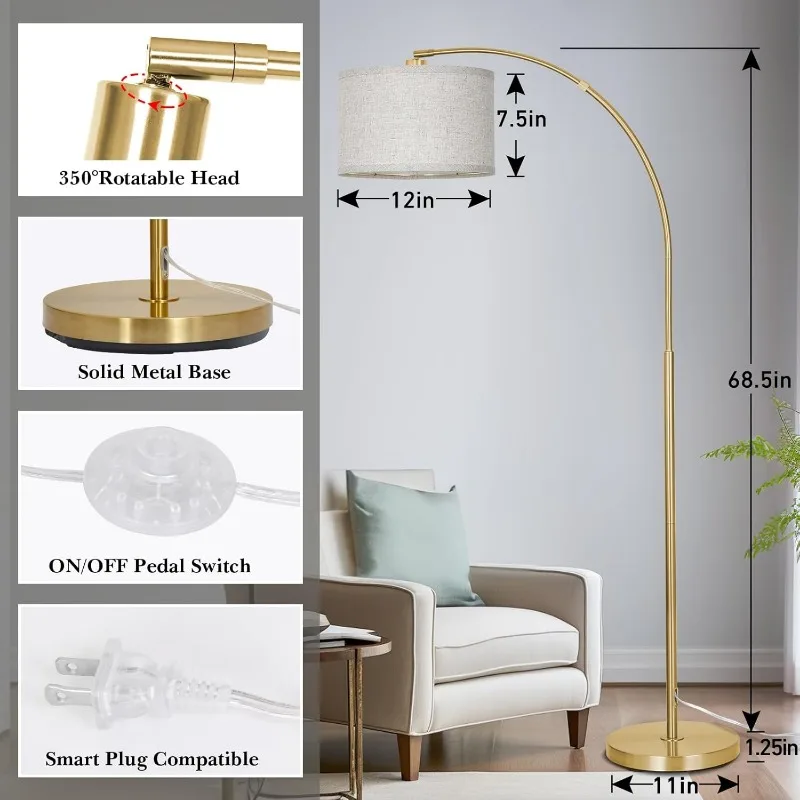
Height-adjustable features introduce additional complexity in pole design. Quality adjustable arc lamps incorporate robust locking mechanisms, often using multiple securing points to prevent slippage or gradual descent under the weight of the lamp head.
For those seeking ultimate stability with modern aesthetics, our black arc floor lamp collection features models with superior pole design and construction that complement their stable bases.
Classic Heavy Disc Base Design Analysis
The iconic heavy disc base represents perhaps the most recognizable arc lamp base design, popularized by classic mid-century modern lamps that continue influencing contemporary lighting design today. This timeless approach combines exceptional stability with sculptural elegance.
Typically featuring a round marble or metal disc with substantial thickness, this design creates an effective counterbalance through both weight and distribution. The circular shape provides omnidirectional stability, allowing the lamp to resist tipping forces regardless of the direction they come from—an important consideration for a statement piece that might be viewed and approached from multiple angles.
The low-profile nature of disc bases creates an extremely low center of gravity that maximizes stability. By concentrating substantial weight just inches from the floor, these designs can effectively counterbalance even dramatic arc lengths without becoming visually overwhelming.
Typical dimensions for effective disc bases range from 10-14 inches in diameter, with thicknesses between 1-3 inches, depending on the material density and arc length. Marble disc bases, with their natural density, can be slightly smaller while providing equivalent stability to larger metal bases.
The aesthetic appeal of disc bases comes from their simplicity and material quality. The clean geometric form creates a beautiful contrast with the organic curve of the arc, while materials like polished marble or brushed metal add textural interest and luxury. This design approach effectively balances visual lightness with physical stability—the base appears as a simple disc rather than a bulky counterweight, despite its substantial mass.
Our metal finish arc floor lamps collection includes several models featuring this classic disc base design, demonstrating how this time-tested approach continues to provide exceptional stability while complementing contemporary interiors.
Rectangular and Square Weighted Base Advantages
While circular bases remain popular, rectangular and square weighted bases offer distinct advantages that make them ideal for certain spaces and design preferences. These geometric bases present a more architectural aesthetic that complements modern interiors while providing excellent stability characteristics.
The primary advantage of rectangular bases lies in their directional stability. By extending the base dimension parallel to the arc’s direction, these designs create targeted resistance precisely where tipping forces are strongest. This allows for efficient use of weight and materials while maintaining excellent stability.
Square and rectangular bases excel in space efficiency. Their clean lines allow positioning flush against walls or in corners, maximizing usable floor space in smaller rooms. This placement versatility makes them particularly suitable for apartments or areas with limited square footage where every inch matters.
The flat sides of these bases also prevent any rolling or movement if accidentally bumped—a practical consideration for busy households. When positioned against walls, rectangular bases can be oriented to extend primarily into the room rather than toward the wall, optimizing both stability and space usage.
Material choices for rectangular bases typically include marble, metal, and engineered stone. The clean lines of these geometric shapes showcase material quality and craftsmanship, with precision-cut edges and corners reflecting attention to detail.
For those dealing with stability issues in existing lamps, understanding how to stabilize arc floor lamp bases can help address problems through proper placement and supplemental weighting. However, purchasing a lamp with an appropriately designed base from the start remains the most effective approach to ensuring long-term stability.
Innovative Fillable and Customizable Weight Bases
Modern lamp design has introduced innovative approaches to the stability challenge through fillable base systems that offer both practical and aesthetic advantages. These designs feature hollow base structures that can be filled with dense materials to achieve substantial weight without the shipping challenges of pre-weighted bases.
Fillable bases solve several practical problems:
- Shipping efficiency: Empty bases ship lighter and at lower cost
- Installation flexibility: Bases can be positioned before adding weight
- Customizable stability: Weight can be adjusted based on arc length and placement needs
- Maintenance access: Some designs allow access to internal components through the fill port
Common filling materials include:
- Sand: Readily available, inexpensive, and with excellent weight-to-volume ratio
- Steel shot: Higher density than sand, allowing more weight in the same volume
- Gravel: Provides good weight with minimal shifting once placed
- Specialty weighting compounds: Engineered specifically for stability applications
When properly filled, these bases can provide stability comparable to solid bases of similar dimensions. The key lies in completely filling the cavity to prevent internal shifting of the weighting material, which could affect balance and stability.
Aesthetically, fillable bases often feature sleek, contemporary designs with clean lines and minimal visual weight. This creates an interesting juxtaposition—bases that appear light and floating visually while providing substantial physical counterweight.
Some advanced designs incorporate combination approaches with permanent internal weights supplemented by fillable sections. This hybrid design ensures baseline stability while allowing customization for specific situations or particularly long arcs.
For consumers, fillable bases offer the advantage of easier transportation not just during initial shipping but for future moves. The ability to empty and refill the base makes relocation significantly more manageable than dealing with one-piece weighted designs.
Multi-Leg and Tripod Base Stability Solutions
Multi-leg and tripod base designs take a fundamentally different approach to stability than solid base models. Rather than relying primarily on concentrated mass, these designs distribute weight across multiple contact points to create a wider stability footprint.
The physics of tripod stability relies on the three-point principle—a structure with three contact points will always find stable equilibrium on a flat surface. This inherent stability makes tripod designs particularly effective when properly engineered with appropriate weight distribution.
Compared to solid bases, multi-leg designs typically:
- Create a wider stability footprint with less material
- Offer a more open, visually lighter aesthetic
- Provide directional stability based on leg positioning
- Allow for interesting architectural expressions through leg design
Effective tripod bases feature legs spread at optimal angles (typically 120 degrees apart) to maximize the stability footprint. The central hub where legs connect must be exceptionally strong, as it bears tremendous stress from both the weight of the lamp and the counterbalancing forces.
Many contemporary designs enhance tripod stability by incorporating central weighting elements—metal discs or other dense components positioned at the leg intersection. This combines the advantages of spread contact points with concentrated mass where it’s most effective.
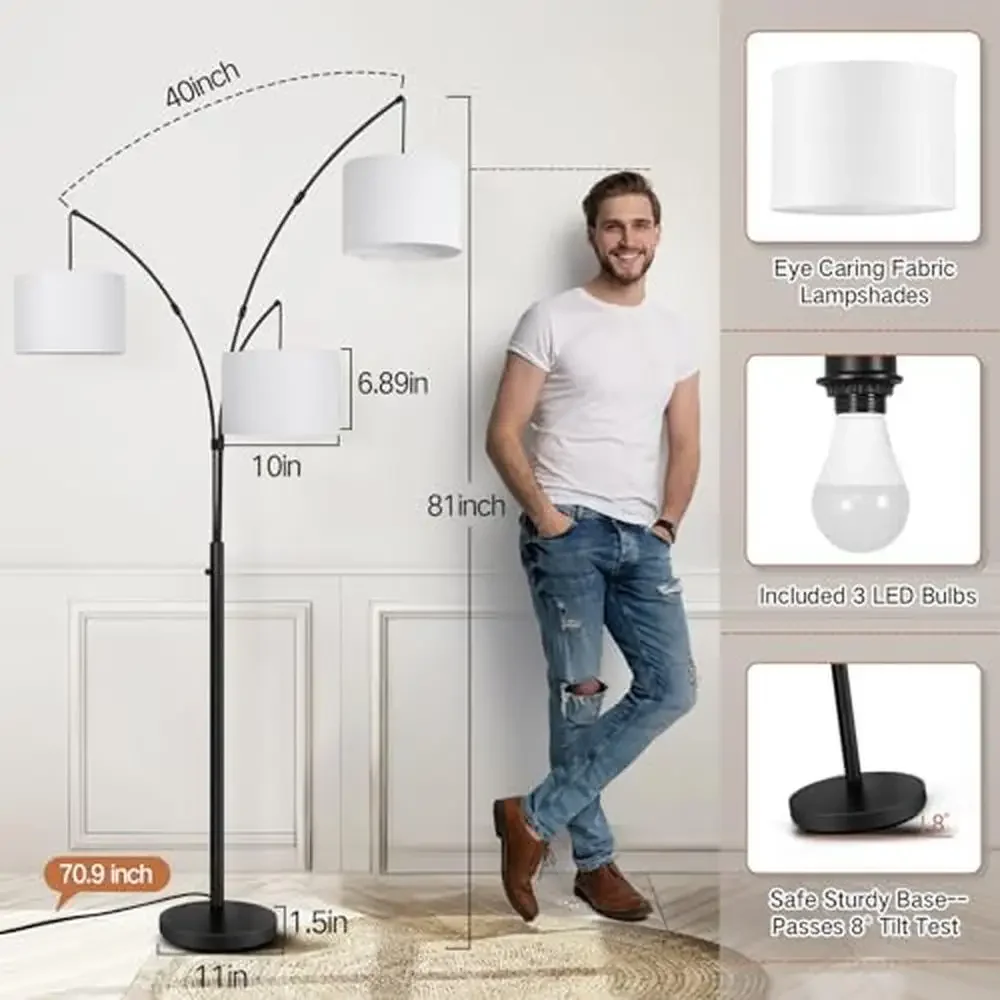
Space considerations differ significantly from solid base designs. While the footprint may be larger overall, the open design creates less visual mass and allows for interesting placement options. The legs can be positioned to accommodate room features or furniture arrangements.
Our multi-light arc floor lamps collection includes several models with tripod bases that demonstrate how this design approach can provide excellent stability while complementing contemporary interiors.
Managing Uneven Surfaces and Flooring Challenges
Even the most perfectly designed arc lamp can become unstable when placed on uneven flooring. Understanding how to manage surface irregularities is essential for maintaining lamp stability regardless of base design.
Uneven flooring creates stability challenges by:
- Changing the lamp’s center of gravity
- Reducing the effective contact area between base and floor
- Creating rocking or wobbling that can loosen components over time
- Potentially directing force vectors in unintended directions
Practical solutions for leveling lamps on uneven surfaces include:
- Thin furniture shims placed strategically under specific areas of the base
- Felt pads of varying thicknesses to create level contact
- Cork or rubber materials that can compress slightly to conform to minor irregularities
- Dedicated furniture levelers designed specifically for lamps and furniture
Adjustable feet represent an excellent feature in quality arc lamps. These engineered components allow fine-tuning of the lamp’s position without external materials. The best designs incorporate threaded feet that can be individually adjusted to compensate for uneven surfaces.
Before attempting any leveling solution, it’s important to check whether the floor itself has significant slopes or irregularities. A simple test involves placing a marble or small ball on the floor—if it rolls consistently in one direction, the floor has a noticeable slope that must be addressed for proper lamp placement.
For more extensive guidance on securing tall lighting fixtures regardless of flooring challenges, our guide on how to secure tall floor lamps provides comprehensive approaches that enhance stability in challenging environments.
Carpet Placement Strategies for Arc Lamps
Carpeted floors present unique challenges for arc lamp stability that require specific strategies and considerations. The soft, yielding nature of carpet—particularly plush or high-pile varieties—can compromise even well-designed base systems.
Different carpet types affect stability to varying degrees:
- Low-pile commercial carpeting causes minimal stability issues
- Medium-pile residential carpeting requires moderate accommodation
- High-pile or shag carpeting presents significant stability challenges
- Carpet padding thickness directly impacts stability regardless of pile height
When placing arc lamps on carpeted surfaces, consider these effective strategies:
- Use thin rigid plates under bases to distribute weight more evenly and prevent sinking
- Select lamp bases with larger footprints that distribute weight across more carpet fibers
- Position lamps where carpet is better supported, such as over subfloor joists rather than between them
- Consider carpet compression over time, which may cause the lamp to gradually lean
Effective materials for under-base support include:
- Acrylic or plexiglass sheets (transparent and visually unobtrusive)
- Thin wood panels finished to complement the lamp design
- Purpose-made furniture support discs designed specifically for carpet placement
Base designs that perform better on carpeted surfaces typically feature wider footprints with distributed rather than concentrated weight. Multi-leg designs can sometimes perform better than solid bases on carpet, as the pointed legs may find more stable positioning through the carpet fibers to the subfloor.
For additional insights on maintaining proper positioning, our resource on how to keep floor lamps from leaning addresses carpet-specific challenges and solutions in greater detail.
Preventing and Fixing Assembly-Related Instability
Even the most well-designed arc lamp can develop stability issues if improperly assembled or maintained. Assembly-related instability represents one of the most common yet preventable problems affecting these sophisticated lighting fixtures.
Proper assembly directly impacts stability through:
- Correct alignment of all components
- Proper tension in adjustable elements
- Secure connections between base, pole, and arc sections
- Even distribution of counterbalancing weight
To ensure optimal stability during assembly, follow these key practices:
- Read manufacturer instructions completely before beginning assembly
- Assemble on a flat, level surface that allows verification of alignment
- Tighten all fasteners to recommended specifications—neither too loose nor overtightened
- Test stability incrementally during assembly rather than only upon completion
Regular maintenance checks should include:
- Inspection of all visible fasteners for signs of loosening
- Gentle testing of joints and connections for any movement or play
- Verification that the base remains level and fully contacted with the floor
- Checking that any adjustable elements maintain their set positions
Common tools needed for proper assembly and maintenance include:
- Quality Allen wrenches or hex keys in appropriate sizes
- Rubber mallet for seating components without causing damage
- Level tool for verifying proper alignment
- Thread-locking compound for connections subject to vibration or frequent adjustment
Warning signs that connections need attention include unusual movement when the lamp is touched, visible gaps developing between components, or gradual changes in the arc’s position over time. Addressing these issues promptly prevents further instability and potential safety hazards.
Are Your Arc Lamps Leaning? Common Causes and Solutions
Arc lamp leaning is a common issue that develops over time, even in well-designed fixtures. Understanding the causes and solutions helps maintain both the aesthetic appeal and functional stability of these statement pieces.
Why do perfectly stable arc lamps develop leans over time?
Component loosening frequently causes gradual leaning. The constant force applied to the arc creates microscopic movements that slowly loosen critical connections, particularly where the pole meets the base. Regular tightening of these connections prevents this progressive issue.
How do floor surfaces contribute to leaning?
Floor surface changes, including carpet compression and hardwood settling, alter the lamp’s position over time. Periodic releveling addresses these environmental changes. For carpet installations, using a larger supporting plate beneath the base distributes weight more effectively and minimizes compression-related leaning.
Can overloading cause arc lamps to lean?
Exceeding the design weight capacity of the arc arm commonly leads to deformation and leaning. This typically occurs when hanging additional items from the arm or replacing the original shade with a heavier alternative. Respecting the manufacturer’s weight specifications prevents this stress-related leaning.
What role does humidity play in lamp stability?
Environmental factors, particularly humidity fluctuations, can affect component fit and material expansion/contraction. This is especially relevant for lamps with wooden elements or those in locations with significant seasonal humidity changes. Consistent indoor climate control helps minimize these effects.
When should leaning be considered a serious concern?
Minor adjustments to position are normal maintenance, but progressive leaning that continues despite adjustments may indicate structural issues requiring professional attention. Similarly, any sudden change in stability warrants immediate inspection of all components.
For comprehensive guidance on addressing tipping hazards before they become problematic, our resource on preventing arc lamps from tipping provides detailed preventative measures and intervention strategies.
Strategic Placement for Maximum Stability and Safety
The strategic placement of arc floor lamps within your home environment significantly impacts their stability, regardless of design quality. Thoughtful positioning enhances both safety and performance while showcasing these distinctive lighting fixtures to their best advantage.
For optimal stability and safety, follow these placement guidelines:
- Position arc lamps away from high-traffic pathways where they might be accidentally bumped
- Allow sufficient clearance around the base to prevent tripping hazards
- Consider the arc’s projection when placing near seating areas to prevent head contact
- Place heavier lamps against walls when possible for additional support and stability
- Ensure the arc doesn’t extend over areas where children play or pets frequently jump
Homes with active children or pets require special considerations:
- Select lamps with particularly stable bases that resist tipping from light impacts
- Consider shorter arc designs that position the lamp head higher above activity areas
- Use cord management solutions to prevent tripping or pulling incidents
- Avoid placement near climbing furniture that could provide access to the lamp
Beyond tipping concerns, safety considerations should include:
- Proper cord placement to prevent tripping hazards
- Adequate distance from curtains, plants, or other potentially flammable materials
- Accessibility to switches or controls without reaching under or around the arc
The interaction between arc lamps and surrounding furniture significantly impacts stability. Placing tall furniture pieces near the base can create a false sense of security while actually increasing tipping risk if the lamp is bumped and falls against the furniture.
For additional placement strategies that enhance both stability and design impact, our guide on how to position arc floor lamps provides room-specific recommendations and visual arrangement principles.
Selecting the Perfect Stable Arc Floor Lamp: Key Considerations
Contemporary Arc Floor Lamp, Large Arc Floor Lamp, Oversized Arched Floor Lamp
$460.63 Select options This product has multiple variants. The options may be chosen on the product pageAdjustable Arc Floor Lamp, Bronze Arc Floor Lamp
Price range: $440.95 through $558.52 Select options This product has multiple variants. The options may be chosen on the product page- Price range: $174.28 through $658.31 Select options This product has multiple variants. The options may be chosen on the product page
Brass Arc Floor Lamp, Contemporary Arc Floor Lamp, LED Arc Floor Lamp
Price range: $490.72 through $522.04 Select options This product has multiple variants. The options may be chosen on the product pageChrome Arc Floor Lamp, LED Arc Floor Lamp
Price range: $304.95 through $1,210.40 Select options This product has multiple variants. The options may be chosen on the product pageContemporary Arc Floor Lamp, Large Arc Floor Lamp, Marble Base Arc Floor Lamp
$224.94 Select options This product has multiple variants. The options may be chosen on the product page
When selecting an arc floor lamp that balances stability with style, consider these essential factors to ensure you choose a fixture that remains secure while complementing your interior design.
Base Weight Assessment:
* For standard arc lengths (40-60 inches), look for bases weighing at least 15-20 pounds
* For longer arcs (60+ inches), bases should weigh 25+ pounds at minimum
* When shopping online, check product specifications for base weight or material density
* If weight isn’t specified, contact the retailer for this critical information
Footprint Evaluation:
* Circular bases should have at least 10-12 inches diameter for standard arcs
* Rectangular bases should extend at least 10 inches in the direction of the arc
* Multi-leg designs should have legs extending at least 12 inches from center point
* Consider room space constraints when evaluating footprint requirements
Construction Quality Indicators:
* Seamless connections between components
* High-quality materials with appropriate density and durability
* Reinforced junction points, particularly where the pole meets the base
* Quality finishes that indicate attention to manufacturing detail
Material Considerations:
* Natural stone bases offer excellent weight-to-size ratio with timeless aesthetics
* Metal bases should be substantial and feature internal weighting
* Avoid hollow plastic components in structural elements
* Check that materials are appropriate for your environment (humidity, sunlight exposure)
When balancing aesthetics with stability requirements, prioritize base design first, as this determines fundamental stability. Then select among styles that meet your minimum stability requirements to find one that complements your interior design vision.
For comprehensive guidance on selecting the perfect fixture for your specific needs, our perfect arc floor lamp guide provides detailed considerations beyond stability that ensure your selection meets all functional and aesthetic requirements.
At Interior Ivy, we carefully evaluate all arc lamps for stability before adding them to our collection, ensuring that style never compromises safety in our curated selections.
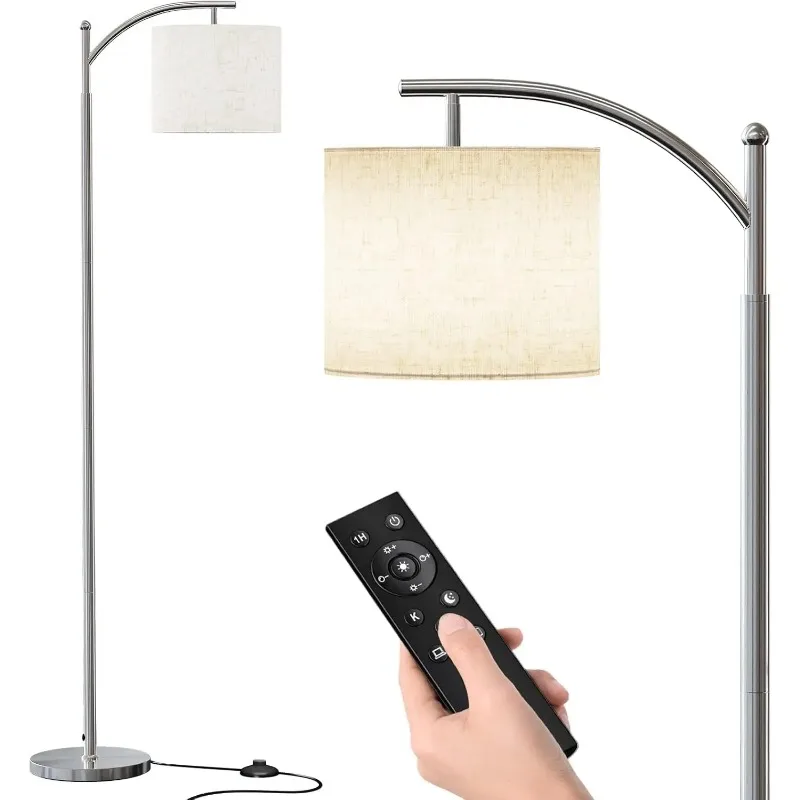
Frequently Asked Questions About Arc Lamp Stability
Are all arc floor lamps inherently unstable?
No, quality arc floor lamps are engineered with proper counterbalancing and weight distribution to ensure stability. While their cantilevered design creates different physical forces than traditional floor lamps, well-designed arc lamps with appropriate base weight and footprint are completely stable under normal conditions.
How do I know if my arc lamp base is heavy enough?
A properly weighted arc lamp should resist gentle pressure applied to the extended arm without tipping or sliding. As a general guideline, the base weight should increase proportionally with the arc length—longer arcs require heavier bases. For typical home arc lamps, bases should weigh at least 15-25 pounds, with larger designs requiring 30+ pounds of counterweight.
Can I add weight to an existing arc lamp base safely?
Yes, with certain precautions. External weights can be added by placing thin, heavy materials (like steel plates) under the existing base, ensuring they don’t extend beyond the base’s footprint. Some hollow bases can be carefully filled with sand or steel shot. However, any modifications should preserve the lamp’s balance and not stress connecting components.
What should I do if my arc lamp is leaning or wobbling?
First, check all fasteners and connection points for tightness. Then verify the floor surface is level and the base is making full contact. Adjust any leveling feet if available. For lamps on carpet, consider placing a rigid plate beneath the base. If these steps don’t resolve the issue, check for component damage or deformation that might require parts replacement.
Are marble bases more stable than metal bases?
Marble bases typically offer excellent stability due to their natural density and weight. However, a well-designed metal base with proper internal weighting can be equally stable. The key factors are total weight and weight distribution rather than material alone. Marble offers the advantage of concentrated weight in a smaller footprint, which can be beneficial in space-constrained settings.
Do more expensive arc lamps always have better stability?
While price often correlates with stability due to better materials and engineering, it’s not guaranteed. Some mid-range lamps with simpler designs may offer excellent stability, while certain expensive models might prioritize avant-garde aesthetics over optimal stability. Always evaluate the specific design elements rather than assuming price alone ensures stability.
Can arc lamps be used safely in homes with children or pets?
Yes, with proper selection and placement. Choose models with particularly stable bases, position them away from play areas and traffic paths, and consider models with shorter arcs that keep the lamp head higher. Our large oversized arc floor lamps include models specifically engineered with enhanced stability for active households.
How do I move my arc lamp without damaging it or my floors?
Disassemble the lamp if possible, separating the heavy base from the arc components. If disassembly isn’t possible, have one person carry the base while another supports the arc to prevent stress on connection points. Use furniture sliders under heavy bases to prevent floor scratching, and cover any marble or stone bases with protective materials to prevent chipping during transport.
Conclusion: Balancing Stability, Style and Function
The quest for the perfect arc floor lamp ultimately requires balancing three crucial elements: stability for safety, style for aesthetic appeal, and function for practical lighting needs. Throughout this guide, we’ve explored how base design fundamentally impacts all three of these considerations.
Weight, footprint, and construction quality form the critical triad of stability factors that cannot be compromised. A well-designed arc lamp incorporates appropriate counterweighting principles, optimal base dimensions, and quality materials assembled with precision. These elements work in harmony to create a fixture that remains steadfastly in position while performing its lighting function.
The beauty of contemporary arc lamp design lies in how masterfully these technical requirements can be integrated into visually stunning forms. From classic marble disc bases to innovative multi-leg designs, stability engineering has evolved alongside aesthetic considerations to create lighting that functions as both furniture and art.
When making your selection, remember that stability is an investment in both safety and longevity. A properly stable arc lamp will provide years of trouble-free performance while remaining a focal point in your interior design scheme. The small premium paid for quality construction and materials returns dividends through both peace of mind and enduring functionality.
By understanding the essential elements of stable base design, you’re now equipped to make informed decisions when selecting these distinctive lighting fixtures for your home or office. The perfect arc lamp awaits—one that balances on that ideal fulcrum between form and function.

